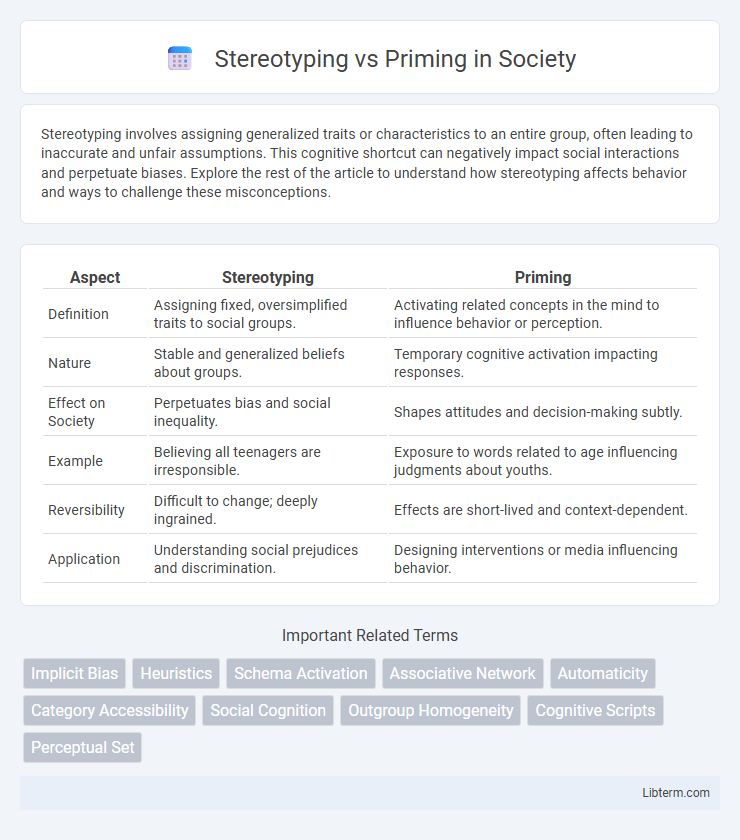Stereotyping involves assigning generalized traits or characteristics to an entire group, often leading to inaccurate and unfair assumptions. This cognitive shortcut can negatively impact social interactions and perpetuate biases. Explore the rest of the article to understand how stereotyping affects behavior and ways to challenge these misconceptions.
Table of Comparison
| Aspect | Stereotyping | Priming |
|---|---|---|
| Definition | Assigning fixed, oversimplified traits to social groups. | Activating related concepts in the mind to influence behavior or perception. |
| Nature | Stable and generalized beliefs about groups. | Temporary cognitive activation impacting responses. |
| Effect on Society | Perpetuates bias and social inequality. | Shapes attitudes and decision-making subtly. |
| Example | Believing all teenagers are irresponsible. | Exposure to words related to age influencing judgments about youths. |
| Reversibility | Difficult to change; deeply ingrained. | Effects are short-lived and context-dependent. |
| Application | Understanding social prejudices and discrimination. | Designing interventions or media influencing behavior. |
Understanding Stereotyping: Definition and Examples
Stereotyping involves attributing generalized characteristics to individuals based on their group membership, often leading to oversimplified and fixed perceptions. Examples include assuming all teenagers are irresponsible or all engineers excel in math, which reinforces biased attitudes and limits accurate individual assessment. Understanding stereotyping is crucial for recognizing its impact on social interactions and promoting more inclusive behavior.
What is Priming? Key Concepts Explained
Priming is a psychological process where exposure to a stimulus influences the response to a subsequent stimulus, often without conscious awareness. Key concepts include activation of related mental associations, enhanced cognitive accessibility, and the automatic triggering of certain behaviors or attitudes. Unlike stereotyping, which involves fixed beliefs about groups, priming temporarily shapes thoughts based on recent exposure to relevant cues.
The Psychological Mechanisms Behind Stereotyping
Stereotyping involves the automatic activation of generalized beliefs about a group, often triggered by social categorization processes in the brain. This cognitive mechanism relies on schemas that simplify information processing but can lead to biased perceptions and unfair judgments. Priming, in contrast, subtly influences behavior or attitudes by activating related mental associations without conscious awareness, highlighting how prior exposure shapes responses through associative memory networks.
How Priming Influences Human Behavior
Priming influences human behavior by activating specific associations in memory, which unconsciously shape individuals' responses and decisions. Research shows that exposure to certain stimuli, such as words or images, can enhance cognitive accessibility, leading people to interpret situations or act in ways consistent with the primed concepts. Unlike stereotyping, which involves fixed and often biased beliefs about groups, priming's effects are temporary and context-dependent, affecting behavior subtly without necessarily reinforcing broad generalizations.
Stereotyping vs Priming: Core Differences
Stereotyping involves assigning generalized traits to individuals based on group membership, often leading to fixed and oversimplified perceptions. Priming activates related mental concepts or associations, influencing responses without conscious awareness or rigid categorization. The core difference lies in stereotyping's reliance on static, group-based assumptions versus priming's dynamic effect on cognitive accessibility and behavior.
Cognitive Processes Involved in Stereotyping and Priming
Stereotyping involves automatic activation of generalized beliefs about a group, often triggered by social categorization and stored in long-term memory schemas. Priming engages cognitive processes by activating specific mental representations or associations, influencing perception, judgment, and behavior without conscious awareness. Both processes rely on implicit memory systems, but stereotyping is more linked to social identity and prejudice, whereas priming often affects immediate cognitive accessibility and response patterns.
Real-world Impacts of Stereotyping
Stereotyping leads to generalized and often inaccurate assumptions about individuals based on group membership, which perpetuates social inequality and discrimination in education, employment, and law enforcement. These biased perceptions result in limited opportunities and reinforce systemic barriers for marginalized communities. Understanding and addressing stereotyping is crucial for fostering inclusivity and reducing real-world social disparities.
Everyday Effects of Priming in Society
Priming shapes everyday behaviors by subtly influencing people's responses to stimuli based on prior exposure, such as how seeing words related to kindness can increase prosocial actions. Unlike stereotyping, which involves fixed, generalized beliefs about groups, priming operates at a subconscious level and can temporarily modify attitudes and decision-making. This effect plays a significant role in social interactions, marketing strategies, and behavior cues in various societal contexts.
Reducing Negative Outcomes: Challenging Stereotypes and Priming
Challenging stereotypes and priming techniques focus on reducing negative outcomes by reshaping automatic associations and cognitive biases. Interventions such as counter-stereotypical exemplars and positive priming cues help disrupt implicit prejudices, fostering more inclusive attitudes and behaviors. Effective strategies include repeated exposure to diverse representations and conscious mindfulness practices that mitigate stereotype-triggered responses.
Future Directions in Research on Stereotyping and Priming
Future research on stereotyping and priming should explore the neurocognitive mechanisms underlying automatic and controlled processing to better differentiate their effects on behavior. Investigating the role of individual differences, such as cognitive control and cultural background, can enhance understanding of susceptibility to stereotype activation and priming effects. Advanced methodologies like neuroimaging and real-time behavioral tracking are crucial for uncovering dynamic interactions between stereotype content and priming stimuli in diverse social contexts.
Stereotyping Infographic

 libterm.com
libterm.com